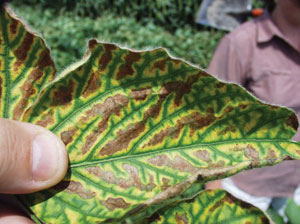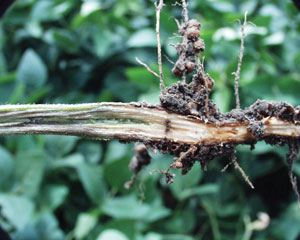
Features
Agronomy
Diseases
Test for SDS in soybeans simple, but a long time coming
Aphids, bean leaf beetles, soybean cyst nematode and phytophthora root rot have been on the minds of most soybean growers for much of the past five years.
November 14, 2008 By Ralph Pearce
Its accuracy is what makes it popular.

|
|
| The most striking symptom of SDS in soybeans includes the discoloration of the leaves. |
Aphids, bean leaf beetles, soybean cyst nematode and phytophthora root rot have been on the minds of most soybean growers for much of the past five years. In researching solutions to these and other pests and diseases, the critical factor in getting the best science into the hands of growers seems to be time. Where sudden death syndrome (SDS) in soybeans is concerned, time is no longer a limiting factor in the chase to impart genetic resistance to the disease in existing varieties.
Dr. David Lightfoot, a biotechnologist at Southern Illinois University-Carbondale, has devised a relatively inexpensive and highly accurate bioassay or test that detects resistance or susceptibility to SDS in soybean varieties. “The tests have a very high success rate for identifying the susceptibles, and it does very well at detecting moderate resistance,” says Lightfoot, adding that such consistency enables researchers and breeders to do more in shorter time frames to build SDS resistance in soybean lines.
It is the consistency of the results that sets it apart from similar research programs. The challenge in researching things like drought or flood tolerance is that the right conditions are not always present or are hard to simulate in a field setting. The SIUC greenhouse assay’s accuracy, however, has been confirmed, both by patent examiners and United States Department of Agriculture (USDA) reviewers. Its cost of about $15 (US) per test makes it even more attractive. “It’s passed every test that’s been thrown at it,” says Lightfoot, noting that other tests, based on the SIUC model have been developed that can be better for a particular type of germplasm. However, those tests are limited to specific temperatures and the use of determinant southern varieties versus indeter-minant northern soybean varieties.
Serendipity strikes again
Lightfoot developed the test with the help of colleagues Dr. Khalid Meksem and Dr. Paul Gibson, who is now retired. It followed an almost inadvertent discovery of the behaviour of inoculum on seeds and soils. “It could sort of identify a very resistant plant from a very susceptible one,” explains Lightfoot. “But when we applied it to cultivars, we obtained what we identified as a complete waste in terms of its usefulness, because it didn’t agree with our field data.”

|
|
| By weakening the stem and roots in soybeans, sudden death syndrome is one more disease challenging soybean growers.
photos courtesy of Albert Tenuta, OMAFRA.
|
At that point, the trio tried to determine what was wrong with the assay, and found the level of inoculum in the soil was inconsistent during various stages of the growing season. “It comes in in the spring and it’s dilute, and then it builds through the growing season and produces SDS when soybean is flowering,” says Lightfoot.
The group then decided they had to grow the fungus in a medium that mimicked a winter soil in Illinois. “We used a clay substitute, a sand substitute and some corn meal to represent the rotting corn plant from the year before, and fairly low temperature incubation of about 22 C,” says Lightfoot. “Then we used low inoculation concentrations of that growth to replicate the low concentration in the spring, and found a much lower concentration than any pathologist would have used as a sensible amount. And when we lined up the data from the field with this new greenhouse assay, the correlation was into the high 80s.”
The assay also provided a stark separation between resistant and susceptible soybean varieties.
Patent process lengthy
In 1996, Lightfoot began the process of patenting the discovery. The patent examiner, however, determined there were actually four areas of invention, and advised him to first secure the molecular markers used in identifying the resistance genes. That patent was issued in 2000, and after another seven years, the greenhouse assay patent was issued, as well. “The nice thing is that there are more patents to come out of that initial submission, which the patent examiner has identified as being inventive and novel,” details Lightfoot. “We can look forward to a couple of more patents on positional plotting of genes and identification of proteins and polypeptides underlying resistance, so it’s the gift that keeps on giving.”
With the patents secure, SIUC can also recoup some of the costs of the research, but more importantly, other universities and laboratories can access the rights to use the assay to further research in SDS resistance and susceptibility. Dr. Istvan Rajcan of the University of Guelph and Dr. Vaino Poysa from Agriculture and Agri-Food Canada are two Canadian researchers who are licensed to use this test. And the timing and geography of the disease is critical. According to projections by Dr. X. B. Yang at Iowa State University and Dr. Harald Scherm at the University of Georgia, SDS is better suited to northern soils and climatic conditions.